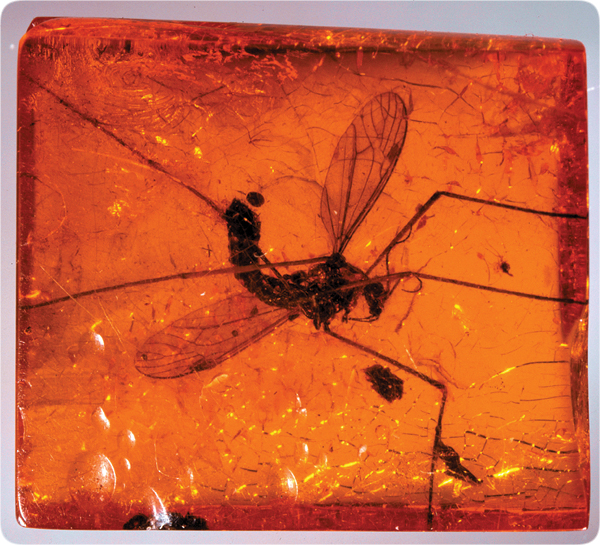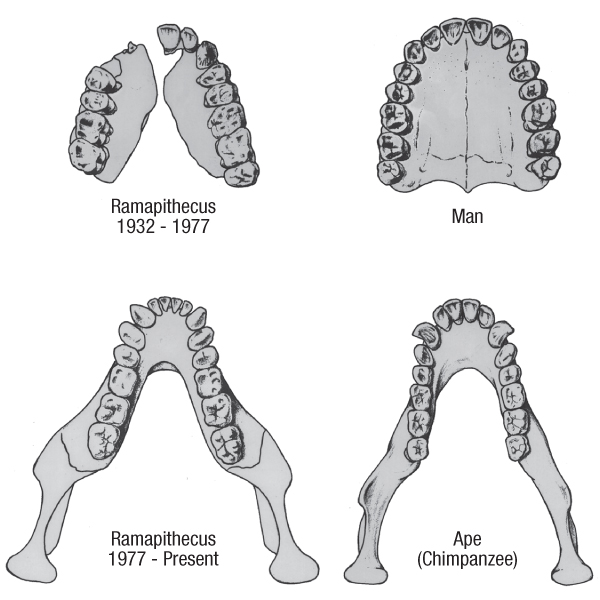Ape-Men? 5
Another study, which examined their inner ear bones, used to maintain balance, showed a striking similarity to those of chimpanzees and gorillas, but great differences from those of humans

. Also, their pattern of dental development corresponds to chimpanzees, not humans (o). Claims were made—based on one partially complete australopithecine fossil,
Australopithecus afarensis, (a 3.5-foot-tall, long-armed, 60-pound adult called
Lucy)—that all australopithecines walked upright in a human manner. However, studies of Lucy’s entire anatomy, not just a knee joint, now show that this is very unlikely. She likely swung from the trees (p) and was similar to pygmy chimpanzees (q). In 2006, a partial
Australopithecus afarensis specimen—a 3-year-old baby—with clear apelike features—was announced (r). The australopithecines are probably extinct apes (s).
n.
“Among the fossil hominids, the australopithecines show great-ape-like proportions [based on CAT scans of their inner ears]
and H. erectus shows modern-human-like proportions.” Fred Spoor et al., “Implications of Early Hominid Labyrinthine Morphology for Evolution of Human Bipedal Locomotion,”
Nature, Vol. 369, 23 June 1994, p. 646. [Many H. erectus bones are probably those of H. sapiens.]
o.
“The closest parallel today to the pattern of dental development of [australopithecines]
is not in people but in chimpanzees.” Bruce Bower, “Evolution’s Youth Movement,”
Science News, Vol. 159, 2 June 2001, p. 347.
p. William L. Jungers, “Lucy’s Limbs: Skeletal Allometry and Locomotion in Australopithecus Afarensis,”
Nature, Vol. 297, 24 June 1982, pp. 676–678.
Jeremy Cherfas, “Trees Have Made Man Upright,”
New Scientist, Vol. 93, 20 January 1983, pp. 172–178.
Jack T. Stern Jr. and Randall L. Susman, “The Locomotor Anatomy of Australopithecus Afarensis,”
American Journal of Physical Anthropology, Vol. 60, March 1983, pp. 279–317.
q. Adrienne Zihlman, “Pigmy Chimps, People, and the Pundits,”
New Scientist, Vol. 104, 15 November 1984, pp. 39–40.
r. Zeresenay Alemseged et al., “A Juvenile Early Hominin Skeleton from Dikika, Ethiopia,”
Nature, Vol. 443, 21 September 2006, pp. 296–301.
s.
“At present we have no grounds for thinking that there was anything distinctively human about australopithecine ecology and behavior. ... [T]
hey were surprisingly apelike in skull form, premolar dentition, limb proportions, and morphology of some joint surfaces, and they may still have been spending a significant amount of time in the trees.” Matt Cartmill et al., “One Hundred Years of Paleoanthropology,”
American Scientist, Vol. 74, July–August 1986, p. 417.
“The proportions calculated for africanus turned out to be amazingly close to those of a chimpanzee, with big arms and small legs. ... ‘One might say we are kicking Lucy out of the family tree,’ says Berger.” James Shreeve, “New Skeleton Gives Path from Trees to Ground an Odd Turn,”
Science, Vol. 272, 3 May 1996, p. 654.
“There is indeed, no question which the Australopithecine skull resembles when placed side by side with specimens of human and living ape skulls. It is the ape—so much so that only detailed and close scrutiny can reveal any differences between them.” Solly Zuckerman, “Correlation of Change in the Evolution of Higher Primates,”
Evolution as a Process, editors Julian Huxley, A. C. Hardy, and E. B. Ford (London: George Allen and Unwin Ltd., 1954), p. 307.
“We can safely conclude from the fossil hominoid material now available that in the history of the globe there have been many more species of great ape than just the three which exist today.” Ibid., pp. 348–349.
[
From “In the Beginning” by Walt Brown]




